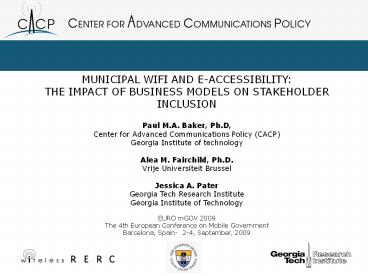MUNICIPAL WIFI AND E-ACCESSIBILITY - PowerPoint PPT Presentation
1 / 16
Title:
MUNICIPAL WIFI AND E-ACCESSIBILITY
Description:
MUNICIPAL WIFI AND E-ACCESSIBILITY: THE IMPACT OF BUSINESS MODELS ON STAKEHOLDER INCLUSION Paul M.A. Baker, Ph.D, Center for Advanced Communications Policy (CACP) – PowerPoint PPT presentation
Number of Views:43
Avg rating:3.0/5.0
Title: MUNICIPAL WIFI AND E-ACCESSIBILITY
1
MUNICIPAL WIFI AND E-ACCESSIBILITY THE IMPACT
OF BUSINESS MODELS ON STAKEHOLDER INCLUSION
Paul M.A. Baker, Ph.D, Center for Advanced
Communications Policy (CACP) Georgia Institute of
technology Alea M. Fairchild, Ph.D. Vrije
Universiteit Brussel Jessica A. Pater Georgia
Tech Research Institute Georgia Institute of
Technology EURO mGOV 2009 The 4th European
Conference on Mobile Government Barcelona, Spain-
2-4, September, 2009
2
WiFI and People with Disabilities
- Bridging the digital divide is a key rationale
for municipal WiFI deployment facilitating more
broadly accessible broadband connectivity with
associated benefits (Bar and Park, 2006) - gt54.4 million Americans (19) (US CENSUS), 10
of the EU or about 50 million (EC estimate) and
650 million globally (UN) have some kind of
long-term or conditional disability - American Disabilities Act of 1990
- Mandates equal opportunity and benefit of U.Sgt
municipal programs and services for people with
disabilities - Mobile technologies as an expansion of modes of
specialized content delivery - Accessibility of municipal websites Project
Civic Access (DOJ 2008)
3
Business Models in Municipal WiFi
- Generic Value Network Model (Van Audenhove et al,
2007)
PUBLIC
Citizen
Infrastructure/Site Provision
Service Provision
Network Building
Infrastructure/Site Provision
Infrastructure/Site Provision
Network Operation
Applications Provision
Customer
Service Provision
Infrastructure Manu/Vending
PRIVATE
COMMUNITY
Floating roles in Value Network
Security
Advertising
Consulting
Helpdesk
4
Business Models in Municipal WiFi II
5
Business Models in Municipal WiFi III
- Stratifications of Municipal WiFi business models
6
Methodology E-accessibility in a mobile context
- Media content analysis on accessibility beyond
the connectivity criteria - Accessibility Scale
- AL (1) Little/no consideration no specific
mention of PWDs or disadvantaged populations - AL (2) Moderate consideration peripheral
mention of underprivileged groups no detailed
goals or intended impacts - AL (3) Substantial consideration detailed
discussion of disadvantaged communities with
specific goals and ideals but nothing specific to
PWDs - AL (4) Specific discussion of PWDs and the
benefits of municipal wireless for this community
7
Results European Municipal WiFi Accessibility
Sensitivity Analysis
- No network received more than a category 2
rating - Bristol had no mention of PWDs
- Cardiff also had no mention, focused on business
development and tourism - Turku champions the sense of community, but no
mention of PWD - Stockholm greater awareness of social
implications - Bologna was more focused on community and
municipal workers, no specific PWD mentions
8
Results US Municipal WiFi Accessibility
Sensitivity Analysis
- Most projects are closely associated with levels
of economic development within the communities - Philadelphia was the only municipality that had
public records referring to PWD - Minneapolis mentions underprivileged groups, but
not disadvantaged - NYC still in development
- Decatur, GA recently built out, no mention of any
specific groups
9
Results Comparative Analysis of Models and
Accessibility Awareness
10
Results Comparative Analysis of Models and
Accessibility Awareness
11
Results Comparative Analysis of Models and
Accessibility Awareness
12
Results Comparative Analysis of Models and
Accessibility Awareness
13
Conclusions
- There is a linkage between the type of
stakeholder group and awareness of the needs for
inclusivity/e-accessibility. - The greater the involvement from institutions
that enable a wider public, the higher the AL
rating the municipal wireless system exhibited. - The private model implies a different driver set
for initial implementation and business goals
while public models with either government or
third party funding for initiation of the WiFi
project may be a factor in consideration - Potential influence of the ADA needs to be taken
into account as Websites (but not currently WiFi
systems specifically) while not specifically
currently covered under Title 2 of the ADA have
been deemed Title 3 public accommodations under
some case law
14
Conclusions II
- The more diverse the stakeholder group the wider
the range of consideration of WiFi user
requirements - Key difference between the Philadelphia
implementation and the others is that business
model category is the fact that service
provisioning was initially done on a wholesale
basis with tiered fees - Agility and adaptability of model allowed for the
transference of network ownership from Earthlink
to a locally formed entity in response to a
changing business climate
15
Wrap-up
- Further information
- CACP www.cacp.gatech.edu
- The authors wish to acknowledge the research and
editorial assistance of Nathan W. Moon, and the
support provided by School of Communications and
Theatre, Temple University. This paper draws on
collaborative work previously developed with
Jarice Hanson (UMASS) and William Myhill
(Syracuse University). Special thanks to
colleague Leo van Audenhove, SMIT, VUB, for
access to the 2006 working paper that preceded
the 2007 South African publication. We also
acknowledge the research assistance of Matias
Medina, recent graduate of Vesalius College /
VUB. - We wish to acknowledge the support of the
European Union Center of Excellence at the
Georgia Institute of Technology, the Center for
Advanced Communications Policy (CACP), Georgia
Tech Research Institute (GTRI), and the Wireless
Rehabilitation Engineering Research Center
(RERC), sponsored by the National Institute on
Disability and Rehabilitation Research (NIDRR),
U.S. Department of Education under grant number
H133E060061. The opinions contained in this paper
are those of the author and do not necessarily
reflect those of the U.S. DOE or NIDRR.
16
Policy Caveat
Die ich rief, die Geister werd ich nun nicht los
From the spirits I have called I now cannot
rid myself Goethe"The Sorcerer's Apprentice"































